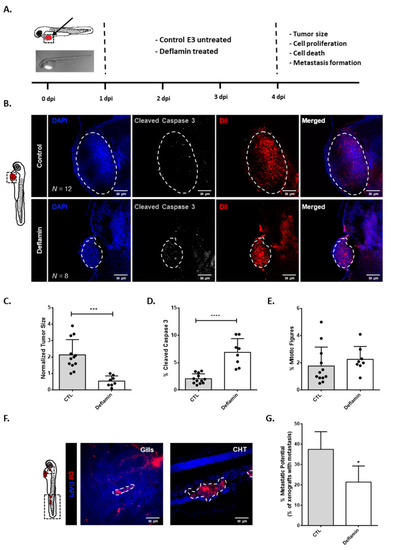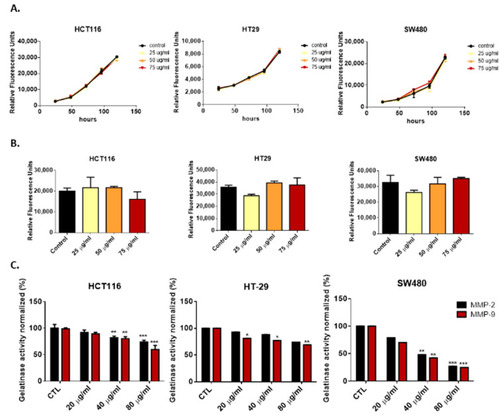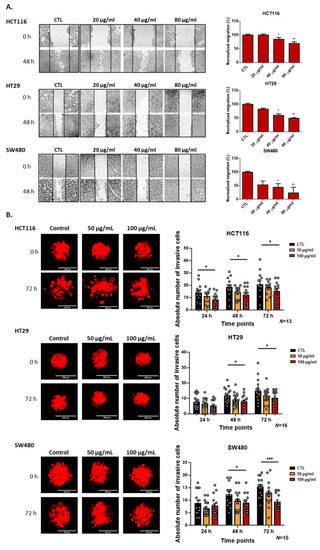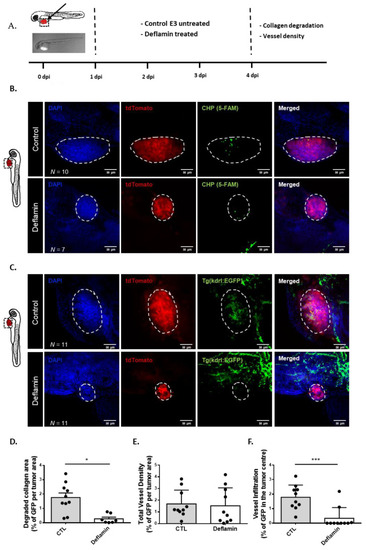- Title
-
Therapeutic Potential of Deflamin against Colorectal Cancer Development and Progression
- Authors
- Silva, S., Cavaco, A., Basso, B., Mota, J., Cruz-Duarte, R., Costa, M., Carvalho, L., Lima, A., Costa, L., Ferreira, R., Martins, M.
- Source
- Full text @ Cancers
|
Zebrafish xenotransplant model of HCT116 cells exposed to deflamin: (A) Human cancer cell line HCT116 was fluorescently labeled with DiI (red) and injected into the perivitelline space (PVS) 2 days post-fertilization (dpf) nacre/casper zebrafish larvae. Zebrafish xenografts were treated in vivo with deflamin for 72 h and compared with untreated controls regarding tumor size, cell death, cell proliferation, and metastasis formation; (B) At 4 days post-injection (dpi), zebrafish xenografts were imaged on PVS by confocal microscopy; (C) Analysis of tumor size (***, p ≤ 0.001); (D) Analysis of activated caspase 3 (apoptosis, ****, p ≤ 0.0001); (E) Analysis of mitotic figures (proliferative cells, ns); (F) Zebrafish xenografts were also imaged over the entire body by confocal microscopy. Representative images of HCT116 micrometastasis in gills and caudal hematopoietic tissue (CHT); (G) % of zebrafish exhibiting metastasis. The number of xenografts analyzed is indicated in the representative images. In the graphs, each dot represents one zebrafish xenograft. Statistical analysis was performed as described in the Statistical Analysis section (*, p ≤ 0.05, ***, p ≤ 0.001, ****, p ≤ 0.0001). Scale bars represent 50 μm. All images are anterior to the left, posterior to the right, dorsal up, and ventral down. |
|
Effect of Deflamin on viability and MMPs of CRC cell lines HCT116, HT-29, and SW480: (A) Viability of human CRC cell lines when exposed to deflamin; (B) Analysis of cell death by apoptosis of human CRC cell lines treated with deflamin; (C) Zymographic analysis of the anti-gelatinases activity of deflamin. Statistical analysis was performed as described in the Statistical Analysis section (*, p ≤ 0.01; **, p ≤ 0.01, ***, p ≤ 0.001). |
|
Migration and invasion of CRC cell lines HCT116, HT-29, and SW480 upon treatment with deflamin: (A) Analysis of migration by the wound healing assay of human CRC cell lines HCT116, HT-29 and SW480 treated with deflamin for 48 h and its corresponding quantification (%) (n = 3). (B) 3D spheroid invasion assay of human CRC cell lines HCT116, HT-29, and SW480 treated with deflamin and the corresponding quantification (number of absolute invasive cells). The number of spheroids analyzed is indicated in the graphs. Statistical analysis was performed as described in the Statistical Analysis section (*, p ≤ 0.05; **, p ≤ 0.01; ***, p ≤ 0.001). |
|
Cancer microenvironment analysis of HCT116 zebrafish xenotransplants: (A) Human cancer cell line HCT116 was stably transduced with FUdtTW plasmid (tdTomato expression marker) and injected into the perivitelline space (PVS) of 2 days post-fertilization (dpf) nacre/casper zebrafish larvae. Zebrafish xenografts were treated in vivo with deflamin for 72 h and compared with untreated controls regarding collagen degradation and vessel density; (B,C) At 4 days post-injection (dpi), zebrafish xenografts were imaged on PVS by confocal microscopy; (D) Quantification of degraded collagen area by analysis of CHP staining (5-FAM stained area); (E) Total vessel density analysis by EGFP marker; (F) Tumor vessel infiltration analysis by EGFP marker. The number of xenografts analyzed is indicated in the representative images. In the graphs, each dot represents one zebrafish xenograft. Statistical analysis was performed as described in the Statistical Analysis section (*, p ≤ 0.05; ***, p ≤ 0.001). Scale bars represent 50 μm. All images are anterior to the left, posterior to the right, dorsal up, and ventral down. |




